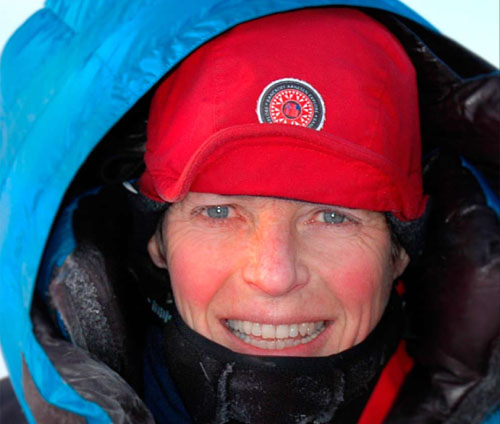![]() Liv Arnesen
Liv Arnesen
Adventurer • Norway
“My hope is that our politicians take action to slow down the melting process in the Arctic”
Liv Arnesen lead the first unsupported women’s crossing of the Greenland Ice Cap in 1992. Two years later she became the first woman to ski solo and unsupported to the South Pole, a 50-day expedition of 745 miles. Author of the book ‘Nice Girls do not Ski to the South Pole’, in 2001 she and American explorer Ann Bancroft became the first women to sail and ski across Antarctica’s landmass, completing a 94-day, 1,717-mile trek.
As an 8 year old, I visited the home of the Norwegian explorer, scientist and Nobel Peace Prize Laureate Fridtjof Nansen. When I returned home, my father gave me his book about his Greenland icecap crossing. Too difficult for an 8 year old to read, this sent me to the school library to find one I could. I found one about Roald Amundsen’s expedition to the South Pole, the book that gave me my childhood dream: to ski to the South Pole. Christmas Eve 1994, more than 30 years later, I reached the South Pole. I had skied solo and unsupported 745 miles in 50 days. Books about the old explorers had mentally prepared me for a much harsher expedition than I experienced. As the days passed on my way, I felt more and more joy and energy. The undulating landscape in white, blue and grey, the patterns in the snowdrifts and the skies, mixed with the poetry I read at night, turned it into a mental expedition. I was pulling a sled of 100 kilos, but it is not the hard work I remember. It is the feeling of being at one with nature, of knowing why I was there, what life is, who I am. I met Ann Bancroft, a former elementary school teacher, in 1998. I had been a high-school teacher for ten years. Ann was born in the cold north of St.Paul, Minnesota, USA, and I in Oslo, Norway. Our parents had the same books about expeditions to both poles on their shelves. From our different, yet common backgrounds, we had the same idea, to use our expeditions as a teaching experience. During our crossing of the Antarctic in 2000-01, our progress was followed by 3 million students in 115 countries, and we made calls to CNN twice a week. To celebrate the 100 year anniversary of the first man to successfully reach the South Pole, Roald Amunden, Ann and I are planning an international women’s expedition in 2011. My greatest worry is for the nature and wildlife of the Arctic. Wtih sea ice melting so rapidly, in August 2008 at a daily rate of 32,700 square miles – an area larger than Scotland – and the methane bomb ticking on land, we need to act urgently. My hope for the future of the poles is that our politicians will take action to stop the daily increasing pollution thereby slowing down the melting process. Unfortunately we are still waiting for the necessary decisions to be taken.

